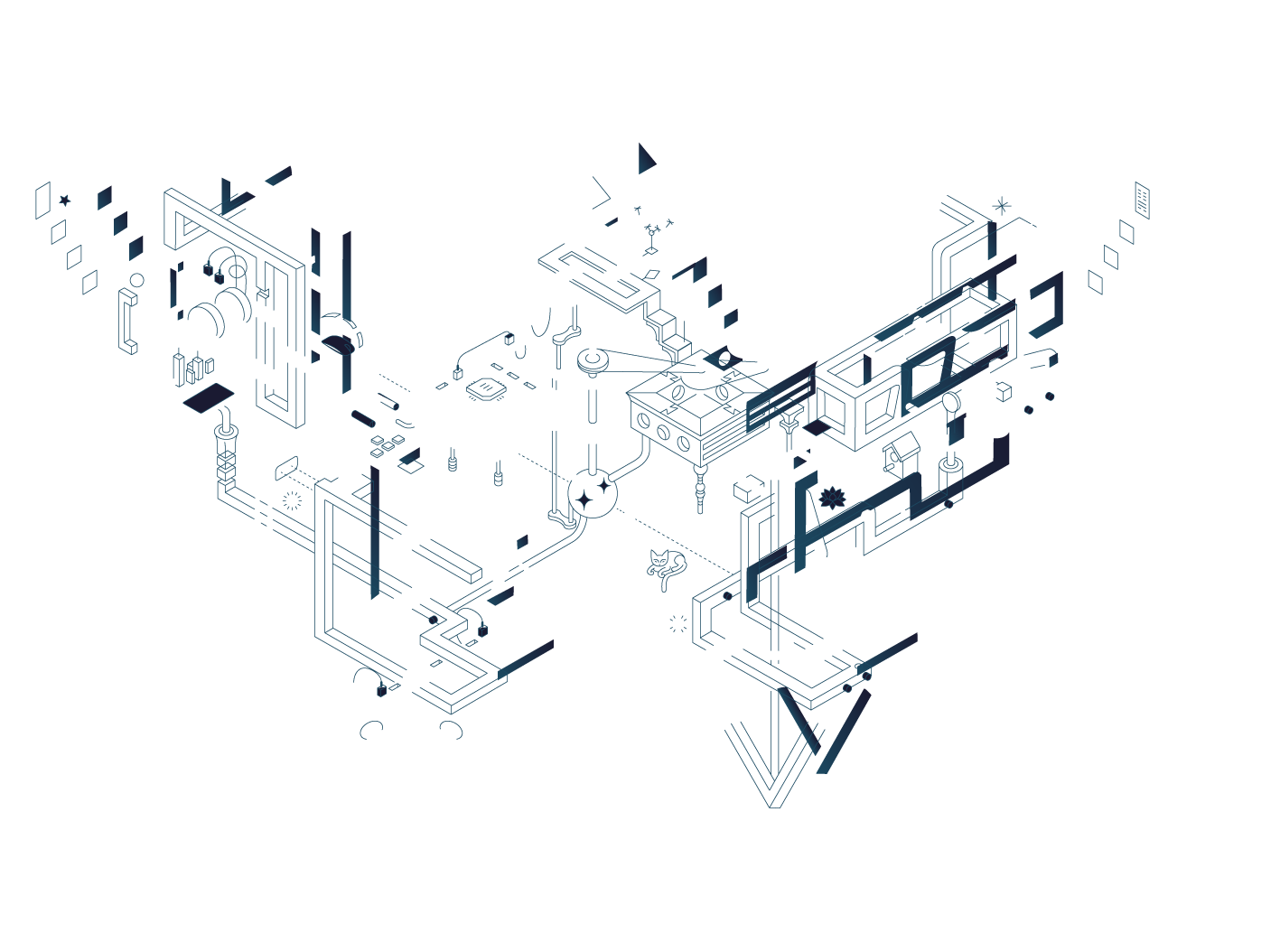Taking Back The Web
by Jeremy Keith
In these times of centralised services like Facebook, Twitter, and Medium, having your own website is downright disruptive. If you care about the longevity of your online presence, independent publishing is the way to go. But how can you get all the benefits of those third-party services while still owning your own data? By using the building blocks of the Indie Web, that’s how!
▲ Top
Systems of Systems
Well built and deeply documented, a design system’s library of design assets and component code are a foundation for independent squads to get things done. However, getting a team to depend on these tools isn’t guaranteed. Which tools do they use, or even need? Who enables access to the tools, if not the team that made them? Who and what does the system itself depend on? And, what do we do when – inevitably – there emerges more than one system to choose from? This talk maps the many connections and relationships we face when applying design systems at scale. It all starts with the fundamental connection: system to product. From there, it explodes into a myriad of relationships and exposes the decisions we face when operating amid this vast landscape of a system of systems.
▲ Top
The Accidental Leader
by Andy Budd
Andy first came to prominence in our industry as a designer and web standards enthusiast. He was driven by a desire to improve and professionalise the industry, which is how he came to start the UK’s first user experience consultancy, Clearleft. He never set out to be a design leader, but now find himself leading a team of thirty people, almost by accident.
In a quest to understand what makes a great leader, and help his friends in newly minted leadership positions, Andy started the Leading Design conference and Slack community last year. Over the past 18 months, Andy has interviewed dozens of prominent leaders and listened in on hundreds of Slack conversations about the art and craft of leadership.
In this session, Andy recounts his journey into leadership, shares his successes and failures, and the important lessons he’s learned on the way. The result is a talk packed full of design leadership heuristics suitable for anybody who is a leader, wants to be a leader, or has a leader.
▲ Top
Language: Your Organization’s Most Important and Least Valued Asset
by Abby Covert
Have you ever felt like differences in language were holding your organization back? Perhaps you have tried to standardize language across parts of your organization only to find you have opened a huge can of worms?
The experiences we make for our users are made of language choices. We also depend on language to collaborate with the people we work with. Yet language is most often only tended to when you talk about things like content and copy.
Controlling your organization’s vocabulary is one of the murkiest messes we can take on, but it also might be one of the most impactful ways we can help our organizations.
In this talk Abby Covert, staff information architect at Etsy, will share with us the strategies and tactics they are using to pay closer attention to language choices they make across both internal and external user experiences.
▲ Top
Be Kind, Design
by Nat Dudley
When the world is going to hell in a hand basket, it’s tempting to put our heads down and keep doing our thing. But we can use kindness and inclusive design to fight back. From form design to data collection to company culture, each of us can take meaningful steps to ensure the work we do every day includes and protects underrepresented groups.
▲ Top
What does it take to go fast?
by Ines Sombra
We all want to move fast. We construct our systems in a rapidly-iterating and agile way. We design and build them to be efficient, robust, and have low latency. But sometimes in the search for speed we make decisions that come back to haunt us. Some of these are reasonable tradeoffs, some can have long-term repercussions, and some can be outright catastrophic.
At Fastly, we serve over 10% of the internet’s traffic and power tens of thousands of online destinations. We have a unique vantage point on the state of the web and going slow is not an option. When Beyonce tweets a baby photo, the NYT breaks a story, or Taylor Swift drops a new album on spotify … our edge cloud sees it first and brings it to you.
In this talk we’ll go over the key lessons we learned while building our edge cloud services with speed: what worked, what didn’t, the tradeoffs we made, and what you can learn from our experiences while building your own distributed applications & teams at scale.
▲ Top
Monsters in the AI Machines
by Kate Crawford and Trevor Paglen
In this double-feature talk, Distinguished Professor Kate Crawford and award-winning artist Trevor Paglen offer a critical look at an emerging landscape of artificial intelligence and autonomous infrastructures in everyday life. Confronting some of artificial intelligence’s foundational assumptions, Kate and Trevor address histories of classification and representation from sixteenth century philosophy to contemporary ‘AI gaydar’, to the tortured relationship between cats and computer vision, to the advent of “invisible images,” to the emergence of monsters and haunted landscapes in algorithmic systems. Kate and Trevor take us on a journey through the strange terrain that is contemporary AI, and show us places where art and critical research meet. While there are no easy answers or ‘quick tech fixes’ to the real concerns about bias built into AI systems, Kate and Trevor suggest new ways to reframe the urgent questions facing us as AI takes on a much bigger role in our lives.
▲ Top
Solving Diabetes with an Open Source Artificial Pancreas
▲ Top
No Way Out But Through: Tales From the Tech Resistance
Like children playing with a bulldozer, the giant American tech monopolies have amassed more power than they can safely handle. Galvanized by the disastrous election, tech workers across America have struggled to organize to meet a rising threat to freedoms we once took for granted, whose loss will have global consequences. A report from a year of hope, fear and failure in the U.S. tech industry.
▲ Top
Inside the belly of the beast: creating change in unlikely places
Millions of Americans interact with government services every day. Veterans apply for benefits. Students compare financial aid options. Small business owners seek loans. Too often, outdated tools and complex systems make these interactions cumbersome and frustrating. Sometimes they simply don’t work.
Government’s failure to deliver digital services that work is disproportionately impacting the very people who need it most. But this is no longer a problem confined to the concerns of government. The growing dichotomy between the beneficiaries of the tech revolution and those it’s left behind is one of the greatest challenges of our time — it’s impacting our politics, our culture, and our institutions.
How do we help reform our organizations and institutions to do better? How do we use our communities skill sets–and our own individual energy–to “be the change?”
Join Haley Van Dyck for lessons from the United States Digital Service–a “start-up” she built inside the White House to help make government services better–on creating change inside large organizations and using your skillets for good.
▲ Top
What we’re trying to say: The arc of UX from desktop and mobile to voice
From the mid-90s to 2010, the concepts of what we think of as modern UX underwent massive growth and shifts in understanding and practice. It started with providing primitive but mind-boggling abilities to access global information and actions on the world wide web, first via personal PCs, and then via personal mobile devices. 10 years after the iPhone was released, we realize we have been both witness and influencers to stunning changes in how people live and interact world-wide.
In roughly that same time period, voice-driven interactions have moved from niche uses to what seems to potentially be a similar sea change. Perhaps we are on the cusp of the third major digital inflection in the span of a generation, and if so, we need to again reframe our thinking of UX practice and impact. This talk will suggest ways we might think about how that arc of digital UX both continues on a logical trajectory, as well as diverges and even jumps to new points of departure.
▲ Top
Sabotaging our future selves
by Laura Kalbag
Who do we really help with accessible technology and why do any of us bother at all? This talk will explore the motivations for our work, and where inclusive design fits in our processes, approaches, outlooks, and lives.
▲ Top
Cultivating Instinct
by Katrina Owen
As novices we slowly and laboriously sift through a chaotic flood of minutia. To experts the significant details are obvious. Irrelevant details fade to the background. The novice receives a jumble of meaningless impressions; the expert sees patterns and meaning.
Somehow experts have made the trek from “How could you possibly tell?” to “How could you not?”. And they probably can’t tell you how they got there.
This talk examines the topic of perceptual learning through the lens of theory and practice—research and anecdotes—and speculates how it can be deployed strategically to train new experts.
▲ Top
The Grass Is Always Greener
by Claire Lew
Employees always think managers have it easier… and managers always think employees have it easier. Sound familiar? As the CEO of Know Your Company, Claire Lew has spent her working life studying 15,000+ employees and business owners in over 25 countries. From four years of research, she’ll share what she’s learned about the disconnect between managers and employees, and what both sides can practically do to work better together.
▲ Top
Digital government: reasons to be cheerful
by Janet Hughes
Governments all over the world are struggling to keep up with the digital age. Some are trying; many are failing. That means services that don’t work for users, and institutions that are ever-more disconnected from the people they are supposed to serve.
Why do government transformation efforts fail, and where is there cause for hope and cheer in the face of all the doom and gloom?
▲ Top
The Power of Business Models and Algorithms
Or, Why We Would Face Most of Our Problems with Digital Technology and Artificial Intelligence even if Silicon Valley Looked like a Benetton Ad, and not another Ruble was spent on Facebook.
In this talk, Zeynep will push back against the notion that a bit more diversity, and a bit of fixing the Russia-meddling-problem would solve the threats of authoritarianism and misinformation and surveillance that haunt the discussion of platforms, digital connectivity and AI.
▲ Top
A short talk about things you already know
by Anna Pickard
We used to have lower expectations. Things that worked were good enough. Once “working” was a given, companies started to notice what people seemed to gravitate toward things that worked *well*. Next came a rapid ascent through “worked well and looked good”, “worked well and felt good”, taking a brief evolutionary diversion into “worked well and had autoplaying audio” that ended up thankfully short-lived. And then there was some more history of the internet. It was fascinating.
Point is, given the fact that everything mostly works, works well enough, and looks great, we’re all trying find different ways to stand out, and to differentiate the apps and services and companies we build. And as we get more and more used to speaking to our technology in a human voice, we’re getting more particular about wanting to hear one reply — whether out loud, or on screen. Personality. Voice. A human touch. The way to achieve these things is not by copying the personality of the app next door, it’s by reaching inside your own experience, and that of your company, and utilising all the skills and habits and hobbies and training you thought you’d left behind in order to do this technology stuff.
This is a talk about examining in a new light how we can take the sum of our experiences up to this point and use them to create for ourselves a way of interacting with humans, as humans, through the apps and services and companies we’re creating. Like the trained web professionals we all are*.
*Spoiler: We’re not. But the fact that we’re not makes us better at being the things we are.
▲ Top
The Innovation Fetish
by Lee Vinsel
Is innovation overvalued? It is the dominant ideology of our era. But what if building, maintenance and repair prove much more important to our daily lives than the vast majority of technological innovations?
▲ Top
A.I. for survival or How feminist, person-of-colour critique will save the world
by Nishant Shah
One of the most visible emphasis in the social acceleration of Artificial Intelligence is what I call an “extinction impulse”. This manifests itself in multiple ways – in how we design-think problems, how we conceptualise our users, how we buy into the promise of A.I. and how we imagine that the answer to our A.I. concerns is going to be more A.I. Following the logic of digital capital and Silicon Valley fueled visions, current digital development in general, and with A.I. in particular, perpetuate myths which we have taken as natural. In this talk, I hope to show how a feminist and person-of-colour critique of these myths, and the alternatives they provide might offer us a more hopeful, inclusive and a humane way of building worlds that are made for survival.
▲ Top
Here’s what everyone will be speaking about:


























